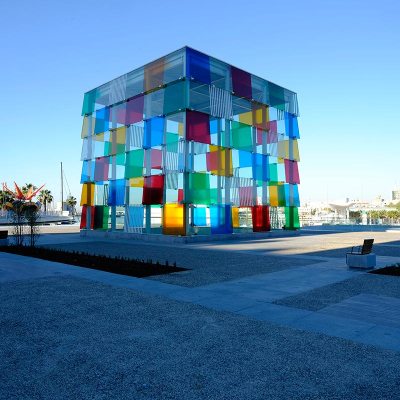Last summer, White Cube Bermondsey put on an exhibition titled ‘The Toxic Sublime’. It presented new work by Marc Quinn, who after subverting classical ideals of perfection in his sculptures of disabled models has begun dismantling Romantic notions of the sublime in a series of distorted and degraded three-dimensional seascapes. Alongside another new group of stainless-steel sculptures titled Frozen Waves (2015), based on the magnified forms of eroded seashells, his Toxic Sublime series is intended to reflect our ‘distanced and complex relationship with the environment’.
Quinn’s new work also reflects a resurgence of interest in the 18th-century concept of the sublime landscape. Looming environmental disaster has given the theme of landscape a political edge and, with it, a new respectability as a subject for contemporary art. Not that all contemporary artists revisiting the subject have taken such a toxic view of the state of nature as Quinn. Ironically, his stainless steel arcs look remarkably similar to the bronze sculptures of rearing waves that Maggi Hambling showed at Marlborough Fine Art in 2010 – works that shamelessly celebrate the undimmed force of nature. It’s a force that, despite the recent spate of floods in the UK, seems to have lost none of its power to thrill – as evinced by The Guardian’s front-page photograph on 9 February of a giant wave crashing against the sea wall at Porthcawl under the impetus of Storm Imogen. Our fears that human intervention has upset the balance of our planet’s climate have not diminished – and may even have sharpened – our aesthetic fascination with its more violent manifestations.
Appropriately, Storm Imogen coincided with the opening at Centre Pompidou-Metz of a new exhibition, ‘Sublime. The Tremors of the World’ (until 5 September), which sets out to explore humanity’s ‘ambivalent fascination with the turmoil of the elements’ through a disparate collection of 300 images, films, and documents dating from the Renaissance to the present day. The arrangement is non-chronological, but most of the historical material conforming to Romantic notions of the sublime – characterised by Edmund Burke in his famous treatise of 1757 as an experience of nature’s immensity and power that triggers pleasurable feelings of terror and astonishment – is concentrated in the introductory galleries. The show opens with images of volcanic eruptions, most of them loans from the Krafft Collection formed by the dedicated volcanologists Maurice and Katia Krafft, who perished in a pyroclastic flow on Mount Unzen in Japan in 1991. Alongside an immense archive of photographs and film recordings – of which breathtaking excerpts are screened in the gallery – the Kraffts collected historical records of eruptions, including the dramatic paintings by 18th-century volcano specialists such as Pierre-Jacques Volaire and Pietro Fabris that illuminate the walls.
Eruption of Vesuvius (1767), Pierre-Jacques Volaire. Courtesy Muséum national d’histoire, Paris
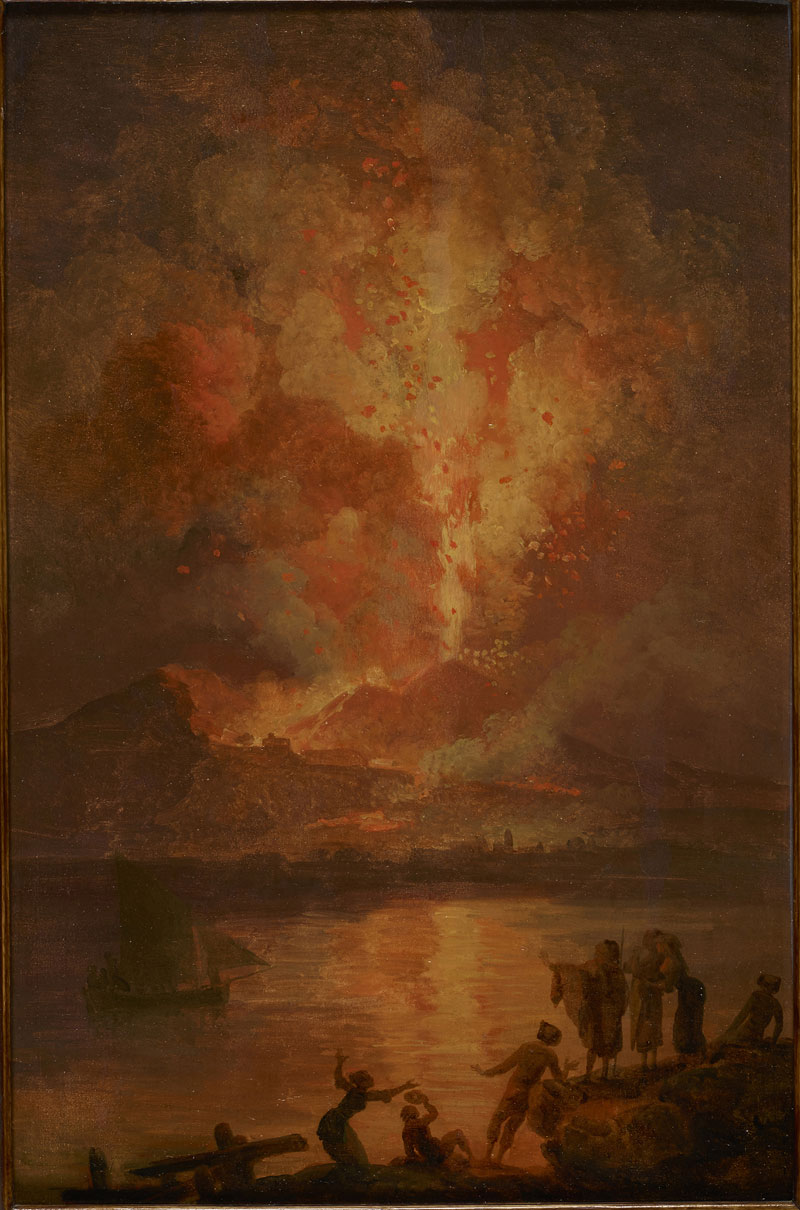
Such images enabled armchair travellers to experience the shock and awe of natural cataclysms within the confines of the picture frame. Their popularity was later eclipsed by magic lantern slides, of which a collection by William Robert Hill is also on display. Projections of volcanic eruptions, Alpine avalanches or desert sandstorms allowed a mass audience to enjoy an aesthetic frisson at the power of nature in the comfort of the Royal Polytechnic Institution on Regent Street. The scale of its eight-metre-wide screens could reproduce the effect of being dwarfed by nature and instil even in city dwellers a humbling recognition of human powerlessness before acts of God.
The fact that natural cataclysms were generally considered acts of God gave the Romantic concept of the sublime a religious dimension. In his treatise, Burke expressed a confident belief in a great chain of causes linked ‘one to another, even to the throne of God himself’ that ‘can never be unravelled by any industry of ours’. Two and a half centuries of unravelling later, his confidence is impossible to sustain and the change of perspective has wrought an inevitable change in our perception of what constitutes the sublime.
The Deluge (1828), John Martin. © The Trustees of the British Museum

The Pompidou-Metz exhibition opens with a film by Adrien Missika titled Darvaza (2011) that looks as spectacular as the Kraffts’ footage of erupting volcanoes: terrifying, astonishing and immense enough to tick most of Burke’s sublimity boxes. But the causes of this contemporary version of the Campi Phlegraei are human: Soviet mining engineers mistakenly drilling into an underground gas cavern in 1971 and igniting the escaping gas to prevent explosions. The 70m flaming hole in the ground thus opened up, christened by locals ‘The Door to Hell’ (‘darvaza’ means ‘door’ in Turkmen), has become a destination on the ‘dark tourism’ trail.
These two alternative visions of doors to hell – one attributed to divine design, the other to human accident – expose a fault line in the curators’ understanding of the term ‘sublime’ that becomes increasingly problematic as the show goes on. But for the first few rooms, contemporary and Romantic notions of sublimity hang together well enough. In a gallery devoted to images of flood, Turner’s Seascape with Storm Coming On (c. 1840) is a not-so-distant relation of Susan Hiller’s On the Edge (2015) – a collection of vintage postcards showing dramatic storms battering Britain’s seaside resorts – while John Martin’s apocalyptic mezzotints of The Deluge (1828) and The Creation (1831) find strong visual echoes in Roland Flexner’s exquisite series of untitled Sumi ink drawings from 2006–07, which seem to evoke the biblical separation of light from darkness through the manipulation of fluid black ink on slick white paper.
Seascape with Storm Coming On (1840), J.M.W. Turner. Courtesy Tate, London
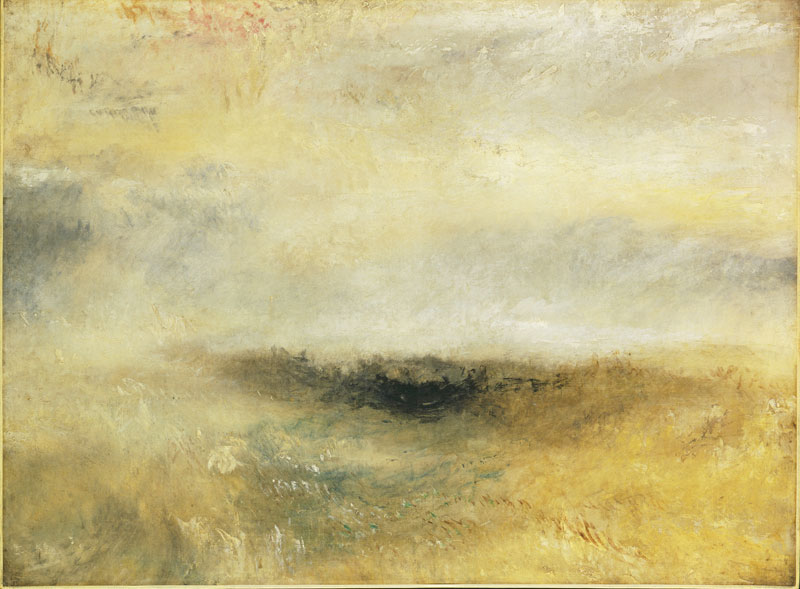
So far, so arguably sublime. But once through the gallery marked ‘Anthropocene’, awareness of our own impact on nature is shown to provoke ‘a sense of paralysing urgency that surpasses simple aesthetic pleasure’. From this point on, Romantic delight in natural thrills and spills tails off into an extended environmental guilt-trip. A few man-made disasters retain their visual power to inspire awe. In a gallery titled ‘Altered Landscapes’, Frank Durnell Conard’s vintage photographs of Approaching Dust Storms in the American Midwest – issued as postcards in the mid 1930s for early ‘dark tourists’ – convey a sense of majesty with their towering peaks of dust threatening to topple on tiny houses, while Edward Burtynsky’s large-format chromogenic prints of vivid orange Nickel Tailings (1996) in Sudbury, Ontario endow creeping contemporary pollution with a lurid beauty. But in the room sensationally titled ‘Nuclear: The Ultimate Sublime’, the show pulls its punches. The line is drawn at exploding atom bombs. Instead we have a filmed interview by Maurizio Lazzarato and Angela Melitopoulos about Fukushima in which the Japanese anthropologist Chihiro Minato makes the baleful observation: ‘Earthquake and tsunami can be mastered – we can rebuild. The relation is dysfunctional with radioactivity.’
Minato’s remark offers some explanation of contemporary art’s apparently dysfunctional relationship with the sublime, and his reference to ‘mastery’ is interesting. The Romantic concept of the sublime belonged to an age of exploration when the image of man testing himself against the elements was inseparable from the idea of conquest. In this context, it’s disappointing that there are no examples here of the American sublime. The Hudson River School rates an entry in the catalogue’s glossary, but its potent vision of an immense New World ripe for discovery is notably absent. Yet of all Romantic visions of sublime landscape this is the one that has proved the most enduring, progressing naturally from the monumental canvas – dramatically displayed behind theatre curtains – to the movie theatre’s big screen. The macho myth of man emerging victorious from a solitary battle with the elements in the immensity of nature has just helped The Revenant to a trio of Oscars. But while cinema is allowed the indulgence of looking back, contemporary art is expected to move forward. There are no obvious heirs to the Hudson River School in the exhibition; the only evidence of America’s continuing love affair with wide open spaces is in images of projects for earthworks by Robert Smithson. In the catalogue Olivier Schefer makes a connection between the nomadic, contemplative American Land Artists of the 1960s and ’70s and the German Romantic figure of ‘the wanderer’ conceived by Caspar David Friedrich – another key figure whose absence from the show is felt.
Wheatfield – A Confrontation: Battery Park Landfill, Downtown Manhattan (composite) (1982), Agnes Denes. Courtesy Leslie Tonkonow Artworks + Projects, New York; © Agnes Denes
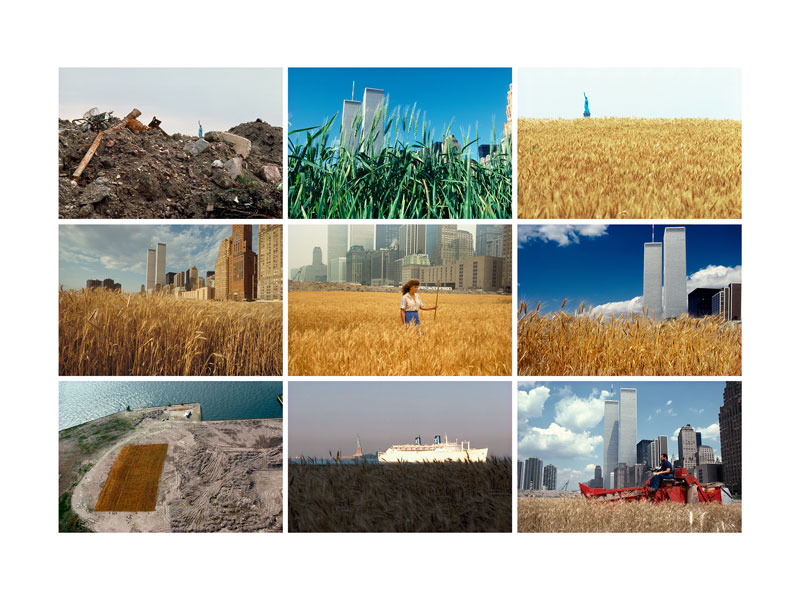
In the final rooms, we’re introduced to a new breed of eco-artists who reconnect ritualistically with the earth. One of them is Joseph Beuys, photographed by Gianfranco Gorgoni in 1971 rising from a threatened marsh near Eindhoven covered in bio-dreck like an eco-friendly swamp creature. Most of them, however, are women artists represented as conciliators rather than conquerors, setting out to ‘repair, nurse and dress the earth’. During one of her Mexican Silueta performances of the 1970s, Ana Mendieta is photographed leaving her ‘body signature’ in flowers on the earth.
How big a yurt can the contemporary sublime be? With the emergence of new categories of the ‘toxic’ and the ‘technological sublime’, the word is in danger of becoming a catchall term for any big and scary unnatural phenomena whose effects we feel humanly powerless to reverse. At the Pompidou-Metz, it is employed as a giant umbrella covering anything vaguely related to the deteriorating state of the environment and artists’ efforts to draw attention to it or even to correct it. Few of the modern and contemporary exhibits fulfil the two basic conditions of Romantic sublimity: aesthetic power and emotional affect. The curators provide sparse evidence for their claim of a revival of artistic interest in the Burkean sublime.
From Silueta Works in Mexico (1974-77), Ana Mendieta. Courtesy Galerie Barbara Thumm, Berlin. Photo: Jean Brasille/Villa Arson
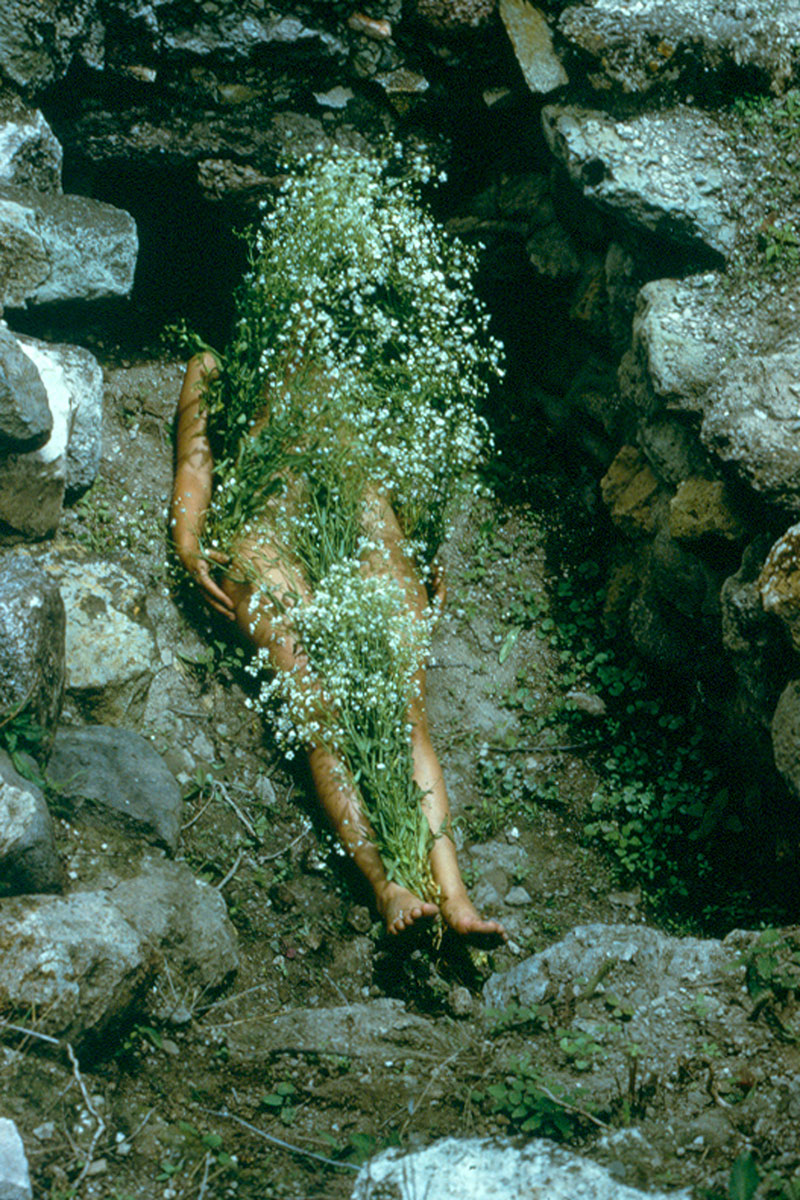
That evidence exists, but is mysteriously excluded from an exhibition that seems more concerned with promoting environmental awareness than inspiring awe. While recognising the ambivalence of our contemporary fascination with the elements, it wants to deliver a non-ambivalent message that is perhaps easier for the museum’s education department to sell. Yet the ambivalence at the heart of the sublime of our godless Anthropocene era is precisely what underlies its aesthetic impact. Nothing demonstrates this more clearly than the work of Burtynsky, which is represented by only two photographs in the show. As a young photographer Burtynsky trod in the footsteps of the great pioneer of landscape photography Carleton Watkins, whose vision of an untamed continent helped establish the myth of the American West. Eventually realising that he was ‘born 100 years too late to be searching for the sublime in nature’, he turned his camera on spectacular sites of environmental devastation caused by mining and drilling. His photographs of the Macondo Blowout in the Gulf of Mexico in 2010 are as visually seductive as his pictures of the Mount St Helens Blowdown of 1983. In moral terms, they might be seen as dangerously ambivalent.
The Anglo-Chinese artist Gordon Cheung, who exhibited alongside Burtynksy in a group show called ‘Vita Vitale’ at the 2015 Venice Biennale, also treads a fine line between the sublime and the toxic. His lurid fantasy landscapes painted on stock-market listings draw contemporary analogies between the state of the planet and industrial capitalism, but their dramatic geography originates in the New World vistas of the Hudson River School, just as their apocalyptic storm clouds derive from John Martin. It’s strange, given the central role of painting in forming our ideas of the sublime, that there are no examples of contemporary painting at the Pompidou-Metz. After all, Gerhard Richter and Anselm Kiefer have both painted monumental canvases of seas and mountains that astonish audiences with their visual impact. German artists have historical reasons for stepping carefully around the traditional territory of the sublime. As Hans-Jürgen Syberberg observed in his 1977 film Hitler: A Film from Germany: ‘Hitler stole our sunsets.’ But the British painter of turbulent seascapes, John Virtue, has no such cultural baggage. His recent touring exhibition, ‘The Sea’, featured panoramas as wide as four metres of the vast void that stretches to the horizon from Blakeney Point in Norfolk.
John Akomfrah’s three-screen video installation Vertigo Sea (2015) – intercutting archive imagery of the slave trade with contemporary film of African migrant crossings and spectacular footage of crashing waves and luminous seas – belongs in the tradition of the terrible sublime established by Géricault in The Raft of the Medusa (1818–19) and followed by Turner in Slavers Throwing Overboard the Dead and Dying – Typhoon Coming On (‘The Slave Ship’) of 1840. The video works of Bill Viola, meanwhile, are contemporary restagings of the Romantic wanderer’s confrontation with the elements, designed to trigger feelings of transcendence rather than horror. In Inner Passage (2013), the artist’s son Blake Viola travels across the Mojave Desert, a landscape in which, in Viola’s words, ‘the physical body confronts extremes of endurance’ and ‘where the metaphysical extremes of loneliness, isolation, stress, anxiety and fear meet the forces of overwhelming beauty, mystery, wonder and ecstasy’. You could hardly wish for a more precise contemporary expression of the Romantic sublime.
Installation view of Over and Over, Again and Again (2004), Mariele Neudecker. © Mariele Neudecker / Courtesy Gallery Leong, New York
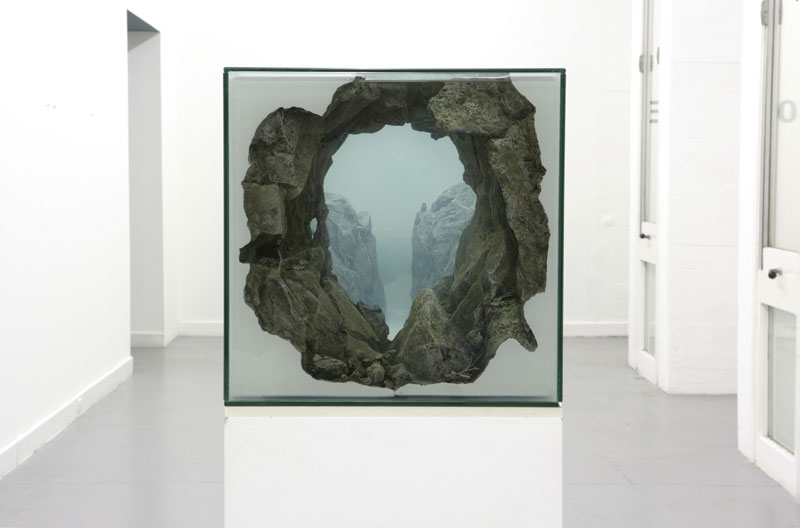
For contemporary artists, the sublime is not all Sturm und Drang. The quiet tradition of contemplation enshrined in the paintings of Friedrich is perpetuated, for example, in the German-born Mariele Neudecker’s miniature models of mountain and forest landscapes, displayed in tanks filled with dye solutions that subtly mimic atmospheric conditions. The title of her early work Stolen Sunsets (1996) was taken from Syberberg. Like 18th-century volcano painters, Neudecker offers the viewer an armchair experience of nature’s majesty contained within a three-dimensional frame, although for modern audiences her scenes are suffused with nostalgia for a Romantic view of unspoilt landscape we can never recapture.
The world has changed almost beyond recognition since 1757 when Edmund Burke, in his seminal treatise, found the ultimate cause of the sublime in divine power. Religious belief was fundamental to Romantic ideas of sublimity, from Friedrich’s advice to artists to ‘close your physical eye so that you may see your picture first with the spiritual eye’ to Ralph Waldo Emerson’s claim that, before the beauties of nature, ‘I become a transparent eyeball; I am nothing; I see all; currents of the Universal Being circulate through me; I am a particle of God.’ Although such sentiments may strike a chord with the Buddhist Bill Viola, they’re unlikely to resonate with many contemporary artists. Yet the image of the Romantic sublime has somehow survived the buffetings of postmodern doubt – its philosophical underpinnings have taken a battering, but its artistic language persists. As Richter recently replied to a question about the state of the art world: ‘Oh, God. It’s gotten absolutely so much worse. But art? Art is sublime.’
‘Sublime. Tremors of the World’ is at the Centre Pompidou-Metz until 5 September.
From the April issue of Apollo: preview and subscribe here.

